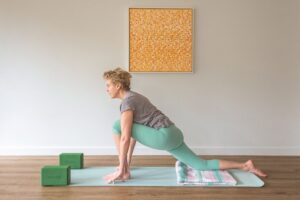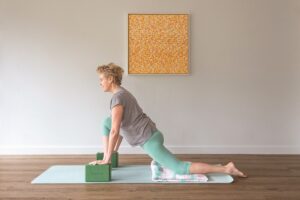March is a lonely, windy month on the Outer Cape. But as it unfolds, we feel the good it brings. The days grow longer and the light brighter. Gradually we find new energy and the inspiration to move.
One of my favorite yoga poses for releasing all that we’ve seemingly stored up through the winter is Dragon Pose. This pose comes from the yin yoga tradition in which one settles into a pose, with support, and holds it for long periods of time. It might seem counterintuitive to hold a pose for a long time to get your energy going. But this quiet way of holding brings circulation to our deeper tissues. Afterwards, you will feel refreshed by it.
To get into Dragon Pose, start on all fours in a tabletop position on the floor or a mat. You will want some cushioning under your knees — you don’t want to feel knee pain in this pose. Step your left foot forward into a lunge. The left knee will be over your left ankle. Now slide your right knee back until you feel a nice stretch in the right hip and thigh. Make sure you’re not resting directly on top of your kneecap but slightly beyond it (towards the bottom of the thigh).

Gently press your front foot into the floor. Allow your hips to move forward until you feel just the appropriate amount of a sensation in the front of your right hip. But how much stretch is appropriate? Yogis call this “finding your edge.” You’ll know you’ve found your edge if you would rate what you feel as a 4 on a pain scale of 1 to 10 — that is, you should feel sensation, but not pain. If you feel sharp pain, electrical sensations, or numbness, back off. Pay attention to your breath. If it is hard to breathe naturally, you are pushing too hard into the pose.
From here, rest your hands or fingertips on the floor. If it’s hard to reach the floor, you may put your hands on blocks on either side of the front foot. To ease up even more, put the blocks inside the left foot.
Now hold the pose for 1 to 3 minutes as the intensity builds. Then come back into tabletop, take a few breaths, and notice the imprint of the pose on that side of your body. Repeat on the other side. When you have done the pose on both sides, take a few moments to lie on your back and notice the effects of the Dragon.

Yin yoga comes from the Taoist tradition and the theory of Chinese medicine. If you have ever had acupuncture, you know it addresses energy meridians that travel up and down your body. The idea is that if the energy is moving smoothly you have more vitality, creativity, and health. Yin yoga is another way of stimulating these energy meridians.
In yin poses, you assume the shape of the pose and then let time and gravity do the work. The deeper tissues, fascia, connective tissues, joints, and bones don’t actually stretch, but they do respond to the gentle tugging or pressure the poses bring to the areas around them.
Doing the Dragon Pose, allow your muscles to be soft, relaxed, and passive. Just use the muscles you need to maintain the shape of the pose. Think of the pose as creating space and circulation in the areas where you feel the stretch.
Yin yoga is sometimes called a bitter practice with sweet results: while we are not entirely comfortable in these poses, we feel a flood of release when we come out of them and often greater ease in movement.



